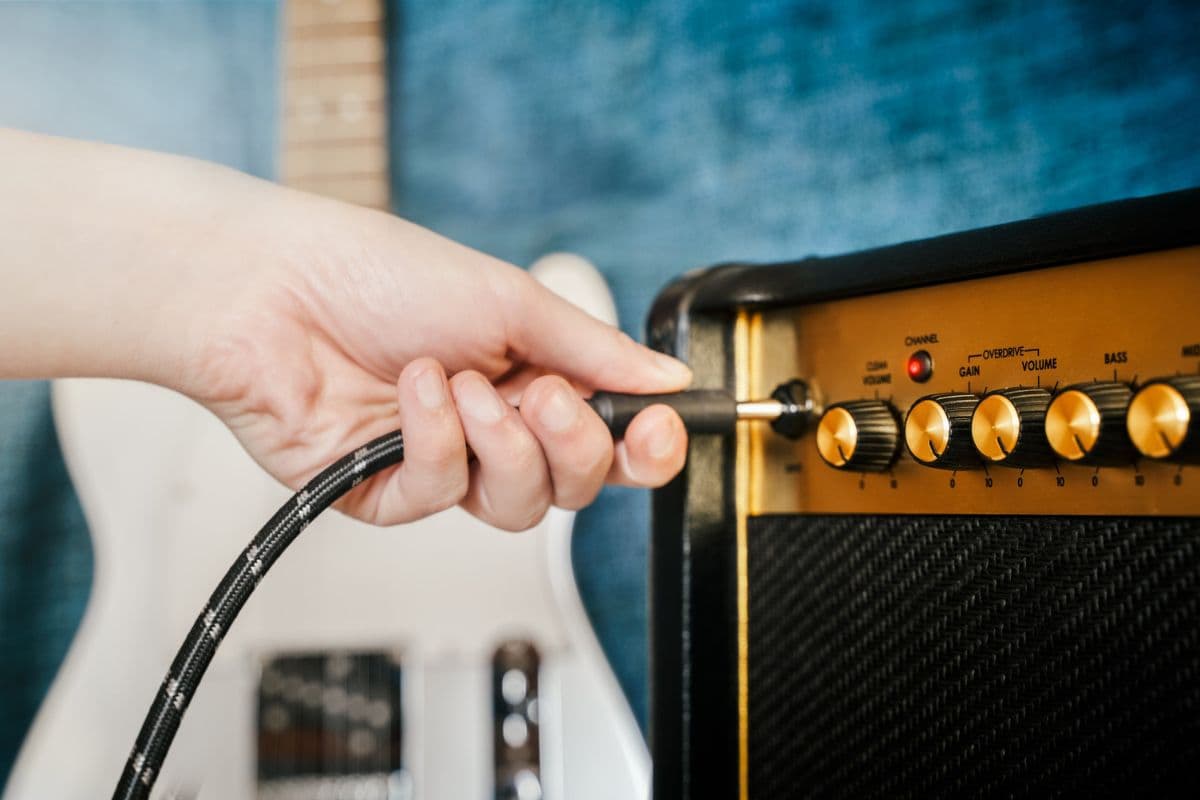As a guitar player, one of the most frustrating problems you might encounter in life is your amp acting up and refusing to work. It is even more frustrating if the problems seem contradictory, like the amp turning on but producing no sound. Such problems need careful deliberation, and you must tread carefully if you wish to correctly diagnose and solve the problem.
If the guitar amp is not working but a light is on, it implies that there is a problem with the wiring or the preamp or amp. Another thing it might point to is a blown speaker. You should also rule out any trivial problems that may arise before you proceed.
This article will cover why your amp might refuse to make sound despite being on. We’ll go over what you can do to correctly diagnose and fix this issue, so you can soon go back to your riffing and soloing.
Guitar Amp Not Working but a Light Is On: 6 Steps to Fix It
If your guitar amp is not working but a light is on, there are a few things you can try to fix it:
- Check the power source: Make sure that the amp is properly plugged into a power source and that the power outlet is working. Sometimes a loose or faulty power source can cause issues with the amp.
- Check the fuses: If the amp has a fuse, check to see if it has blown. If the fuse is blown, replace it with a new one. Fuses can often be found on the back of the amp, near the power input.
- Check the cables: Make sure that all of the cables connected to the amp are securely plugged in. Loose or faulty cables can cause issues with the sound.
- Check the volume and tone knobs: Sometimes the issue may be with the volume or tone knobs. Make sure that they are turned up and that the amp is not on mute.
- Check the tubes: If your amp uses tubes, it is possible that one or more of them have gone bad. You can check the tubes by visually inspecting them or using a tube tester. If a tube is bad, replace it with a new one.
- Seek professional help: If none of these steps work, it may be time to take your amp to a professional for repair. They will be able to diagnose the issue and make the necessary repairs.
In any case, be sure to follow all safety precautions when working with electronic equipment, and if you are not comfortable with any of the steps listed above, seek professional help.
If you want to find out what my recommended guitar gear is, then here is what I recommend on Amazon:
- Fender Cutaway Acoustic-Electric Guitar Bundle (MY FAVORITE GUITAR)
- Snark SN-8 Super Tight All Instrument Tuner (Easiest Tuner I’ve Used)
- 6 String Acoustic Guitar Capo (Best CAPO for quick changes)
- Dunlop Max Grip 1.0mm Nylon Picks (Thick Guitar Pick So You Don’t Lose Grip!)
- Universal Guitar Stand (Cheap & Minimalist Guitar Stand I Recommend)
- Levy’s 2″ Wide Quick Adjust Guitar Strap (Best Guitar Strap For Any Level)
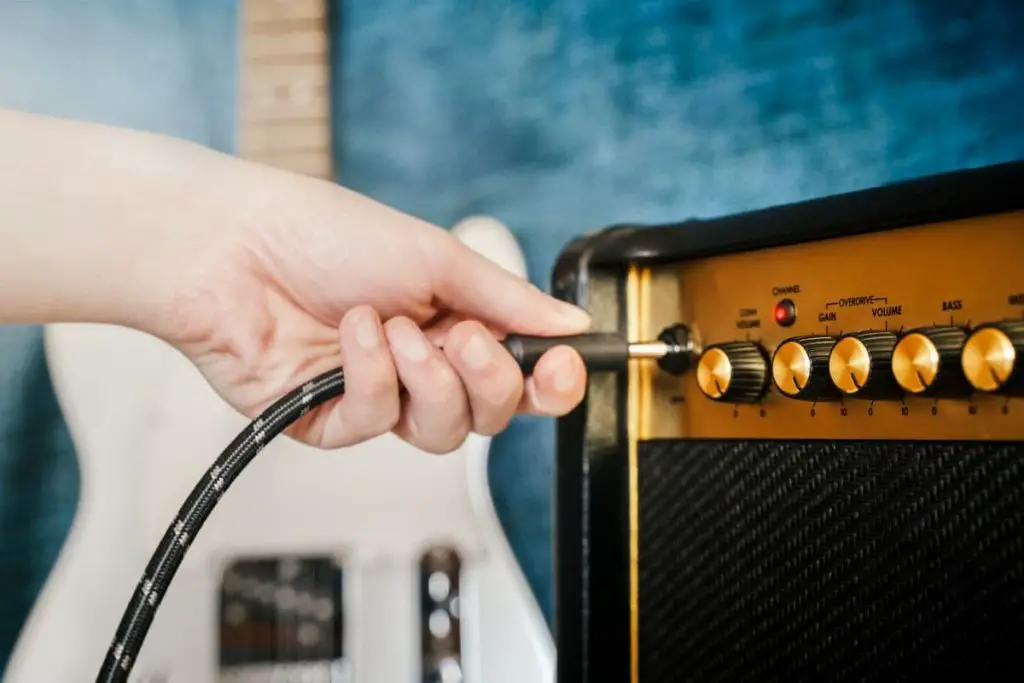
1. Rule Out Trivialities for Fixing the Guitar Amp
Many seemingly complex guitar problems are often caused by trivial things that we simply don’t notice. Instead of rooting out the simple issues first, we’re often prone to beating our heads against the wall in frustration because we can’t find the source of what’s preventing us from playing music. All the while, the basic issues are right under our noses.
I’ve been frustrated with my amp not working countless times, only to see that my guitar’s volume was turned all the way down. When facing a problem, it’s best to go over the most basic problems to save yourself time and potentially money.
Often, a guitar amp not working will seem catastrophic, and we’ll automatically look for a big problem, ignoring everything else. You might think at such moments that so much trouble can’t be caused by something simple.
However, checking for trivial problems and solving them on the go will only take a few minutes, and it might prevent you from wasting time and money on a wild goose chase. Plus, you risk causing damage anytime you change something on your amp, which might set you back a few hundred or even a few thousand dollars.
Instead of risking that, go through the basics first. Here are some things you should do:
- Check if the cable is working.
- Inspect the jacks for rust.
- See if your guitar is turned up.
- Check if the amp is turned up.
- Inspect the pedals.
Let’s briefly examine why these things are important.
1. Check if the Cable Is Working
A faulty guitar cable won’t allow signals to be transferred from your guitar to your amp, making it sit quiet. Guitar cables break and get damaged easily, plus they are prone to corrosion and oxidation, so it is very likely that you’ll have problems with your cable rather than amp.
If you have a spare cable, try using that one to connect your guitar to the amp. It only takes a minute of your time and might save you from a big headache down the road.
It is always a good idea to have more than one cable precisely because of this kind of situation. It’s even more important if you play live. You don’t want to be left without a cable during a concert, so you have to walk off the stage in shame.
You can also inspect the cable for signs of corrosion and physical damage. These are sure signs that the cable is not fit for use anymore, and you shouldn’t feel sorry to throw it away or keep it as a weird decoration.
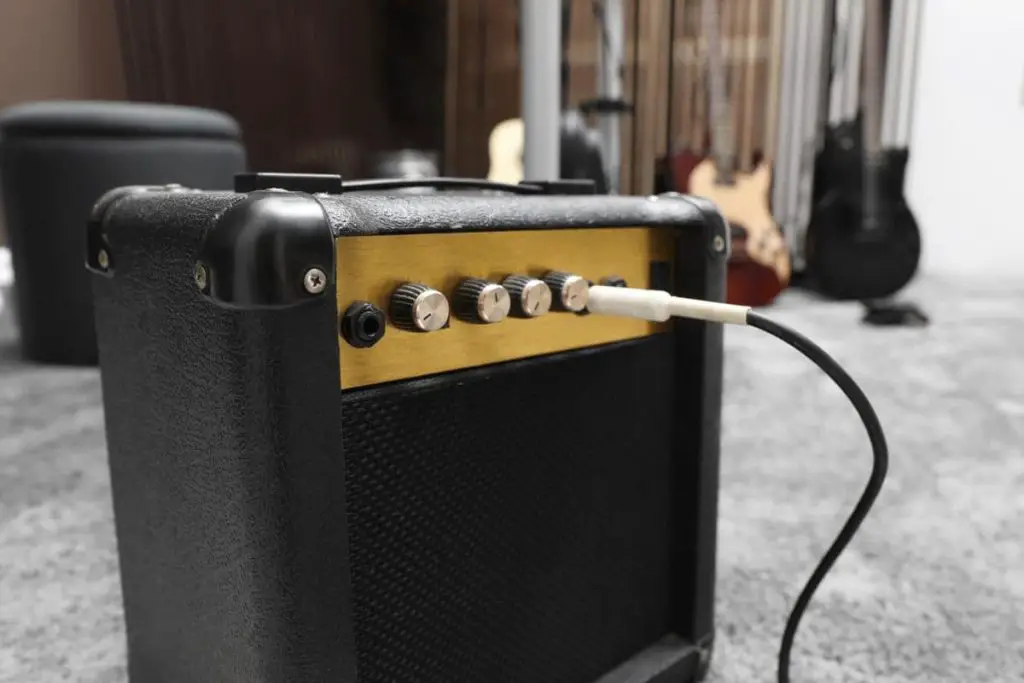
2. Inspect the Jacks for Rust
Jacks tend to corrode if your musical equipment is not stored properly. It doesn’t happen that often, but it is an occasional occurrence, and it is very easy not to notice this problem until it is too late.
This can happen to the output jack on your guitar and to the input jack on your amp. If you are really unlucky, it might happen to both. This will naturally prevent your guitar’s signal from being transmitted, resulting in a silent amp.
Jacks are easily replaceable, so even if something is wrong with them, you can get rid of the problem quickly. Replacement jacks usually only cost a handful of dollars, and as long as you buy the right ones, there will be no problems.
3. See if Your Guitar Is Turned Up
This should go without saying, but it happens more often than one might think. It’s very easy to forget that your guitar’s volume knob is turned all the way down, and you might start strumming without turning it up.
Usually, people figure it out after a few moments, but it’s not completely impossible to see someone desperately looking for a solution for their silent guitar amp only to figure out that their guitar was simply turned down.
While this usually results in a good laugh, it is best not to waste time on such a trivial problem, so make sure that your guitar is turned up. It’s good to develop a habit of checking for this before you begin playing, so you’re sure that everything is set up correctly.
4. Check if the Amp Is Turned Up
This is almost identical to the first problem. You might easily turn on the amp while forgetting about the master volume knob and leaving it turned down. This will give you the wrong impression that there’s something wrong with the amp, while it’s functioning perfectly and the problem is you.
It is best to always take a few minutes to inspect the knobs on your amp and set them up according to your needs. This will let you notice if the master volume is turned down, preventing frustration.
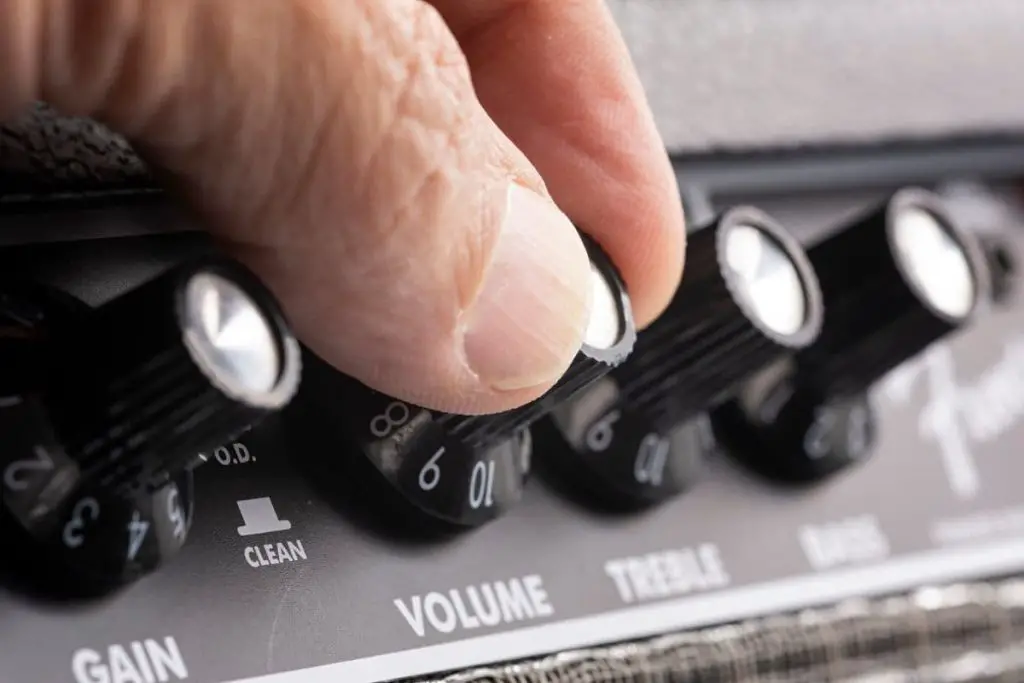
5. Inspect the Pedals
Pedals can often cause problems with your gear. The more pedals you have, the more things can go wrong. If you are the kind of guitarist who likes to play around with pedals, take a close look at them if you run into problems.
Make sure that all the cables are connected properly and that everything is turned up. With a bunch of pedals, it is very easy to overlook a misconnected cable or one that is not connected at all.
Once you’ve gone through all the trivialities and the problems are still there, you can move on to more serious troubleshooting steps. Let’s see how.
2. Why Is the Guitar Amp Light On, but There’s No Sound?
If the light on the amp is on, but the amp is not making any sound, it means that it is powered properly, so there is probably no need to inspect that. However, the speaker, preamp, or amp might be the problem. This requires close inspection, but it’s not too difficult to get to the root of the problem.
Let’s see what you have to do.
Listen
The key to troubleshooting problems with your amp is listening to it carefully. If there is absolutely no sound coming from the amp’s speaker, not even floor noise, the speaker is likely blown. This occasionally happens to guitarists who play at exceedingly high volumes.
On the other hand, if there is some hissing or buzzing, the speaker is likely working properly, and the problem is in the preamp or internal circuitry. This problem is somewhat worse, as it requires more technical knowledge, and those parts of the device are more intricate in their design.
How To Deal With a Blown Speaker
If your amp speaker is blown, you can either replace it or fix it. Replacing is more common, but it’s not as daunting as it seems. Fixing it is also not a particularly difficult task, and anyone with a basic grasp of soldering and electronics can pull it off.
Here’s what you have to do:
- Unscrew the grill covering the speaker.
- Gently remove the speaker
- Inspect the cone and the voice coil, looking for tears and ruptures.
If the speaker cone has a small tear or rupture, it can be easily fixed with scotch tape or glue. If it is completely destroyed, you’ll have no choice but to replace the entire speaker. Fixing such a cone would probably not yield great results.
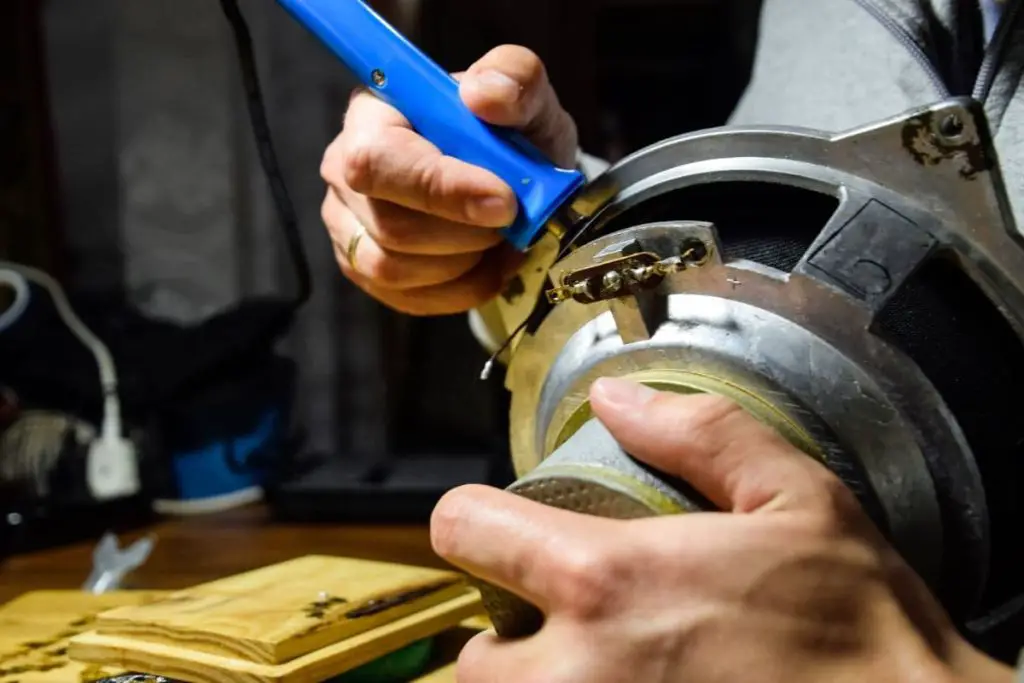
On the other hand, a voice coil can’t be fixed or replaced. If the voice coil is damaged, there is no choice but to replace the speaker. Replacing is a bit more difficult than fixing, but if you’re not confident in your skills, find a technician to do this for you.
If you are certain that you know what you’re doing, you can try changing the speaker on your own.
Here’s what you have to do:
- Record the speaker’s serial number, resistance, and power handling information. You need this information to find the right speaker.
- Scour the Internet and physical shops for a replacement speaker. Don’t skimp out on it.
- Remove the old speaker.
- Solder the wires to the new speaker.
- Put it in the hole.
- Test the new speaker.
- If it works, reattach the grill.
Speakers are not replaced that often. Guitarists more often replace their amps, but it is much cheaper to replace the speaker, and it’s far less wasteful. Throwing away the whole amp is not the best idea if the other components still work properly.
Plus, installing a new speaker might do wonders for your tone. You’ll easily find a speaker that is much better than your old one, which will have an overwhelmingly positive effect on your sound. Thus, you can turn the misfortune of having amp problems into a benefit.
What To Do if the Guitar Amp Speaker Works Fine
If there is some noise coming from your speaker, it means that it would also transmit the signal from your amp if there were any. This points to a problem with the amp circuitry. The bad news is, this problem can be anywhere in the circuitry.
However, with some knowledge of amp circuitry and careful listening, you can easily narrow down the problem to small parts of the circuitry and fix the problem that way. Let’s see what to look out for.
You should primarily listen to the noise floor. Noise floor is the noise your amp makes on its own, even if there is no signal. If the noise floor is quieter than usual or not present at all, you likely have a problem with the amp.
The presence of noise floor implies that the amp is working more or less correctly, but the signal from your guitar just can’t reach it for some reason. If there is noise floor, but it’s quieter than usual, it might imply a problem with the preamp.
Noise floor can also be louder and more aggressive than usual. This implies that there is a broken piece that introduces the noise. That can be an active component such as a transistor or tube, or a passive component. They’d have to be replaced in both cases to solve the problem.
However, listening for noise floor is not completely reliable. Most people won’t even know what their amp’s noise floor is like generally, which makes it difficult to see if there is a difference from the noise the amp usually makes.
It’s also possible that the amp was broken the entire time you’ve had it, so you don’t have a clear idea of what its noise floor sounds like. On the other hand, if it has worked well, then the noise floor was probably quiet and unobtrusive, so you may not have even noticed it.
However, listening for noise floor will give you a rough idea of what might be wrong with your amp, which is always a great beginning. You’ll have to inspect the amp physically as well, but at least you’ll know what to look at.
Check All Inputs and Outputs
If your guitar amp has more than one input, you should test both. If neither produces sound, then the problem is likely in the circuitry after the channels merge. If one is silent, then the problem is likely only in it, which greatly narrows the problem.
If there is an aux output, test that one as well. If it makes sound, there is probably a problem within the circuitry after the aux. If not, then the interruption most likely precedes it.
After locating the problem, inspect the area closely to see what might be happening. When it comes to replaceable parts like tubes, you’ll simply have to install new ones. If there is a problem with the wires, you’ll likely have to resolder them.
You should also get rid of any debris that you find. Dust and other particles can interfere with the signals and diminish the sound quality you get from your amp. Even if that’s not the root of the problem, you should always take a minute to remove dust and other kinds of dirt.
3. Taking Care of Your Guitar Amp
The best way to deal with amp problems is to avoid them in the first place. Investing a bit of effort in the maintenance of your guitar amp will save you a lot of trouble and will mean that you won’t have to spend your time chasing problems in your amp’s circuitry instead of jamming.
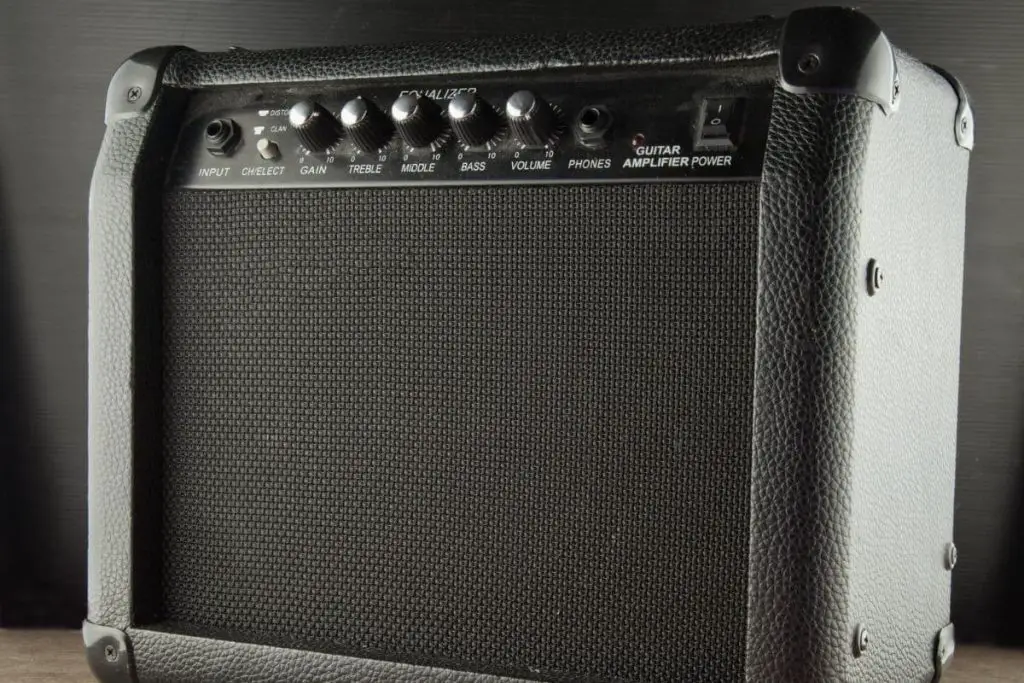
You should always keep your amp away from extreme temperatures. Both extreme heat and extreme cold might damage it and ruin its sound. While you won’t have problems after driving in a cold car with your amp to a gig, consistently keeping your amp in a too cold (or too hot) room won’t be good for it.
It should also be protected from dust at all times. The easiest way to do this is to buy an amp bag, but if that’s not an option, covering it with a blanket or a piece of nylon will do the job just fine. Dust is one of the biggest causes of amp problems, so eliminating dust will eliminate most of the problems.
Another huge cause of problems is liquids. As you can imagine, getting your amp soaked in coffee or beer will not positively impact its tone. Even though it might be tempting to put a coffee mug on your amp while playing, the convenience of it won’t make up for the potential damage if you spill the coffee. An amp is not a coffee table.
Of course, your amp should also be protected from impact and pressure. Don’t let it tumble around your car’s trunk and don’t put heavy objects on it. Be careful not to hit it when carrying it, and don’t ever drop it unless you want an amp in pieces. Most of all, don’t sit on it, even if your legs hurt like hell.
Guitar Amp Not Working but a Light Is On: Conclusion
If the guitar amp is not working but a light is on, then that means that your amp is powered but some internal components are broken. It might be the speaker, which is easier to fix, but it might be the amp circuitry, which is more difficult to diagnose and fix.
You need to carefully inspect your amp and listen carefully for the noises it makes, which will help you determine where the problem is.
Guitar Amp Not Working (No Sound) FAQ
Here are some common questions about the guitar amp not working with no sound.
Why is my amp on but not working?
If your guitar amp is on but not working, there may be a few different reasons why this is happening. Here are some possible causes:
- Faulty cables: One of the most common reasons for an amp not working is a faulty cable. Check all the cables that connect your guitar, effects pedals, and amp to ensure they are functioning properly and not damaged.
- Tube issues: If your amp uses tubes, they may need to be replaced. Tubes can wear out over time, leading to reduced sound quality or no sound at all.
- Speaker problems: If your amp is on but not producing any sound, there could be an issue with the speaker. Check to make sure it is properly connected and not damaged.
- Power issues: If the amp is getting power but not functioning, there may be an issue with the power supply. Make sure the amp is plugged into a functional power outlet.
- Other technical issues: There could be other technical issues with your amp that require professional repair.
If you have ruled out the basic issues and the problem persists, it is recommended to take your amp to a qualified technician for repair.
How do I know if my guitar amp is blown?
If your guitar amp is blown, you may notice several symptoms such as distorted or crackling sound, no sound at all, or a burning smell coming from the amp. Additionally, you may also see physical damage, such as a cracked or broken speaker cone, burnt-out tubes or components, or damage to the input/output jacks.
To determine if your amp is blown, you can try the following steps:
- Check the power source: Make sure your amp is properly plugged in and the power source is working.
- Check the cables: Ensure that all cables and cords are connected properly and not damaged.
- Test the guitar: Plug your guitar into a different amp to ensure that the issue is with your amp and not your guitar.
- Check the tubes: If your amp has tubes, check to see if they are glowing when the amp is on. If they are not, they may need to be replaced.
- Test the speaker: Play a sound through your amp and listen for any crackling or distorted sound. If the sound is not clear, the speaker may be blown.
- Take it to a professional: If you are unable to diagnose the issue, it may be best to take your amp to a professional technician for repair.
It is important to handle your guitar amp with care to prevent damage and ensure it stays in working condition.
Why isn’t my guitar amp turning on?
If your guitar amp isn’t turning on, there could be a number of reasons why. Here are a few things you can check:
- Power supply: The first thing you should check is that your amp is plugged in and the outlet is working. Make sure that the power cord is securely plugged in on both ends.
- Fuse: Check to see if your amp has a fuse that might have blown. If so, replace the fuse with one of the same rating.
- Volume and gain: Make sure the volume and gain on your amp are turned up, as it may seem like the amp isn’t working if the levels are too low.
- Switches: Check all the switches on your amp to make sure they are in the correct position.
- Tubes: If you have a tube amp, it’s possible that one or more of the tubes have burned out or gone bad. You can test this by replacing the tubes with new ones.
- Speaker: Check the speaker to make sure it is properly connected and not blown out.
If none of these solutions work, it might be time to take your amp to a professional for repair.
Why does my amp get power but no sound?
If your guitar amp is getting power but producing no sound, there could be several reasons for this. Here are some possible causes:
- Faulty speaker: If the speaker is damaged, it may not produce any sound. You can check this by plugging in a different speaker to see if it works.
- Faulty tubes: If your amp has tubes, one or more of them may be faulty or worn out. You can check this by replacing the tubes and seeing if the sound returns.
- Broken connections: Check all cables and connections to make sure they are properly plugged in and not broken or loose.
- Blown fuse: A blown fuse can cause the amp to stop producing sound. Check the fuse and replace it if necessary.
- Volume control: Make sure the volume control on your guitar and amp are turned up, as well as any other tone controls.
If none of these solutions work, it may be time to take your amp to a professional for repair.
How do you reset a guitar amp?
Resetting a guitar amp can help in resolving issues with the sound or function of the amp. Here are the steps to reset a guitar amp:
- Turn off the amp and unplug it from the power source.
- Locate the reset button or switch on the amp. It is usually found at the back of the amp.
- Press and hold the reset button or switch for a few seconds. You may need to use a small object like a paper clip to press the reset button.
- Release the reset button or switch and plug in the amp.
- Turn on the amp and check if the issue has been resolved.
If the issue persists, it may be best to consult a professional guitar technician or bring the amp to an authorized repair center for further diagnosis and repair.
Do guitar amps have fuses?
Yes, many guitar amps have fuses that are designed to protect the amp from electrical surges or other issues that could cause damage. Fuses are typically located on the back of the amp, near the power supply, and can usually be accessed by removing a panel or cover. If your guitar amp is not working, it may be worth checking the fuse to see if it has blown and needs to be replaced. It’s important to use the correct type of fuse when replacing it, as using the wrong one could cause damage to the amp.
Can you fix a broken amp?
It depends on the extent of the damage and the cause of the problem. Some issues with guitar amps can be fixed relatively easily, such as replacing a blown fuse or fixing a loose wire. Other issues, such as a blown speaker or damaged circuit board, may require more expertise to repair. In some cases, it may be more cost-effective to replace the amp rather than repairing it. It is recommended to take your amp to a qualified technician for repairs.
Will a guitar amp turn on with a blown fuse or without a fuse?
A guitar amp will not turn on without a fuse, and if the fuse is blown, the amp may turn on but will not produce any sound. The fuse acts as a safety device that protects the amplifier’s electrical components from power surges or short circuits that could damage them. When the amp is turned on, the electricity flows through the fuse before it reaches the rest of the circuit. If there is a problem, the fuse will blow, interrupting the flow of electricity and preventing damage to the rest of the components. If the fuse is blown, it needs to be replaced with the same type and rating for the amp to work properly.
What causes an amp to burn out?
There are several things that can cause an amp to burn out. Here are some of the most common causes:
- Overheating: If an amp is used for an extended period of time, it can overheat and damage the internal components. This can cause the amp to burn out.
- Power surge: If there is a power surge in the electrical supply, it can cause damage to the amp. This is because a power surge can cause the voltage to rise, which can damage the sensitive internal components.
- Incorrect power supply: If an amp is connected to the wrong power supply, it can damage the amp. This is because the wrong power supply can cause too much or too little voltage to be supplied to the amp.
- Electrical short: If there is an electrical short in the amp, it can cause damage to the internal components. This can cause the amp to burn out.
- Speaker overload: If the speakers connected to the amp are overloaded, it can cause the amp to burn out. This is because the amp will have to work harder to produce the sound, which can cause the internal components to overheat.
It is important to take good care of your amp and avoid these common causes of burnout to prolong the life of your equipment.
How long should a guitar amp last?
The lifespan of a guitar amp can vary greatly depending on various factors such as usage, maintenance, and quality. On average, a well-maintained and high-quality guitar amp can last for several decades. However, if the amp is used frequently and not maintained properly, it may need repairs or replacement within a few years. It’s important to regularly clean and service the amp to ensure its longevity.
What does a broken amp sound like?
A broken amp can produce a variety of sounds, depending on the nature of the problem. In some cases, the sound may be distorted, crackling, or hissing, while in other cases there may be no sound at all. A broken amp can also produce other unusual sounds, such as popping or buzzing. Some problems may only affect certain frequencies or channels, while others may affect the entire sound output.
If you want to find out what my recommended guitar gear is, then here is what I recommend on Amazon:
- Fender Cutaway Acoustic-Electric Guitar Bundle (MY FAVORITE GUITAR)
- Snark SN-8 Super Tight All Instrument Tuner (Easiest Tuner I’ve Used)
- 6 String Acoustic Guitar Capo (Best CAPO for quick changes)
- Dunlop Max Grip 1.0mm Nylon Picks (Thick Guitar Pick So You Don’t Lose Grip!)
- Universal Guitar Stand (Cheap & Minimalist Guitar Stand I Recommend)
- Levy’s 2″ Wide Quick Adjust Guitar Strap (Best Guitar Strap For Any Level)
Related Posts:
- 10 Reasons Why Guitar Amps Buzz (and Easy Fixes)
- Acoustic Electric Guitar Not Working With Amp? 4 Fixes
- How To Tune Your Electric Guitar Without an Amp
- How To Test an Electric Guitar Without an Amp
- Electric Guitar vs. Acoustic Amp: Differences Explained
- Will an Electric Guitar Damage a Bass Amp?
- Will an Acoustic Amp Work With an Electric Guitar?
- How To Create A Dummy Load For A Guitar Amp
- Best Guitar Amps: tube, solid-state and modeling amplifiers for all budgets (Acoustic, Electric)

